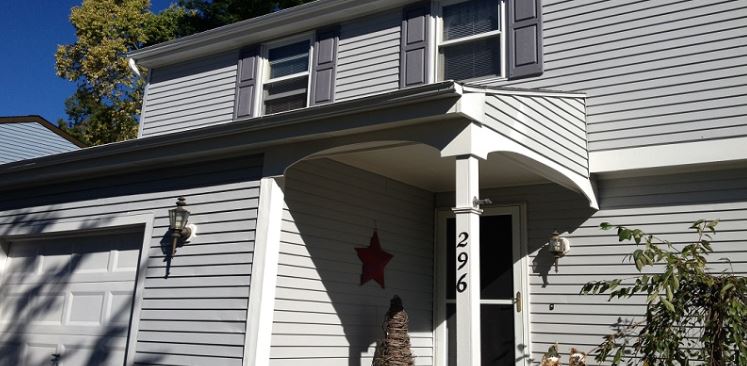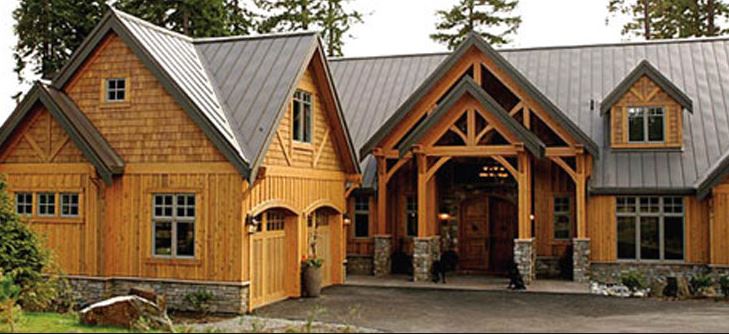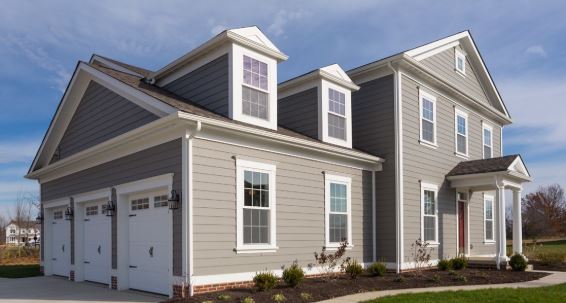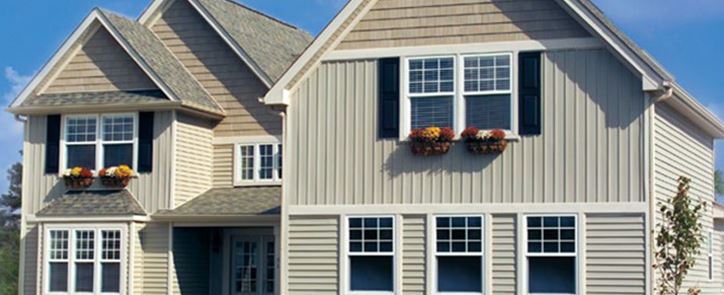
by Beckworth LLC | Jun 14, 2018 | Remodeling, Siding, Virginia Remodeling Blog
Pros and cons of insulated vinyl siding
Some of the benefits of insulated vinyl siding are improved energy efficiency, low-cost and durability but that does not mean its the best option for your home as we will cover the pros and cons of this type of siding. Insulated vinyl siding offers many benefits for homeowners and builders alike as a low-cost alternative to other more costly options like Stone Veneer or Cedar Shake.
Vinyl siding is making a big come back from when it was being replaced by concrete or wood siding options which can provide a more authentic appearance but considering the cost and durability, it is a hard option to not consider. The insulated properties also add to the reasons you should consider if you want to cut costs during summer and winter by having more stable internal temperatures thanks to the additional insulation from the elements.
Insulated Vinyl Siding Cost
There is a large range of pricing options for this type of material because many factors affect its face value like the brand, color, and profile being used. If you plan appropriately and stick to your budget then vinyl siding can be a very good option for you with prices ranging from $1.50 to $4.00 per square foot.
Pros of Insulated Vinyl Siding
A newer development in Vinyl Siding is the range of color options many manufacturers are now offering.
- R-Value of 3 or Higher
- Stronger resistance to impacts
- Thermowall insulation foam option
- Vapor permeability to allow your siding to breath
- Can even be installed over old siding in some cases
- Manufactured pieces can come in any size or cut
- Better sound control properties
- Less maintenance
- Variety of colors
- Energy Tax Credits
- Reduced energy bills
Cons of Insulated Vinyl Siding
- To prevent warping, proper installation methods should be followed
- To avoid damage, waterproof barriers should be installed
- High moisture can develop mold
- If not attached properly, can be blow of by strong winds
Insulated vinyl Siding
If you’re considering new siding for your home, call Beckworth for a free quote (703) 570-6777, or use our contact form. You can also find good resources on our Blog or Facebook page.

by Beckworth LLC | Jun 8, 2018 | Siding, Virginia Remodeling Blog
Pros and Cons of Insulated Vinyl Siding
Some of the benefits of insulated vinyl siding are improved energy efficiency, low-cost and durability but that does not mean its the best option for you home as we will cover the pros and cons of this type of siding. Insulated vinyl siding offers many benefits for homeowners and builders alike as a low-cost alternative to other more costly options like Stone Veneer or Cedar Shake.
Vinyl siding is making a big come back from when it was being replaced by concrete or wood siding options which can provide a more authentic appearance but considering is cost and durability it is a hard option to not consider. The insulating properties also add to the reasons you should consider if you want to cut costs during summer and winter by having more stable internal temperatures thanks to the additional insulation from the elements.
Insulated Vinyl Siding Cost
There is a large range of pricing options for this type of material because many factors affect its face value like the brand, color and profile being used. If you plan appropriately and stick to your budget then vinyl siding can be a very good option for you with prices ranging from $1.50 to $4.00 per square foot.
Pros of Insulated Vinyl Siding
A newer development in Vinyl Siding is the range of color options many manufacturers are now offering.
- R-Value of 3 or Higher
- Stronger resistance to impacts
- Thermowall insulation foam option
- Vapor permeability to allow your siding to breath
- Can even be installed over old siding in some cases
- Manufactured pieces can come in any size or cut
- Better sound control properties
- Less maintenance
- Variety of colors
- Energy Tax Credits
- Reduced energy bills
Cons of Insulated Vinyl Siding
- To prevent warping, proper installation methods should be followed
- To avoid damage, waterproof barriers should be installed
- High moisture can develop mold
- If not attached properly, can be blow off by strong winds
Insulated Vinyl Siding
If you’re considering new siding for your home, call Beckworth for a free quote (703) 570-6777, or use our contact form. You can also find good resources on our Blog or Facebook page.

by Beckworth LLC | May 19, 2018 | Remodeling, Siding, Virginia Remodeling Blog
Aluminum Siding
Aluminum siding is one of many home siding options an owner must consider when choosing the new exterior for their home. The options can be overwhelming, especially if you have no idea what the differences are between wood, vinyl and aluminum. Fortunately, Beckworth LLC can help you with the planning process as well as the installation and replacement of your old siding.

Aluminum Siding
One of the most important factors to consider when thinking about getting aluminum siding is the location of your home in regards to the weather and environment. Aluminum siding can be an excellent option for your home as long as you take these things into consideration.
Aluminum panels come in both a horizontal format and a vertical format, allowing the homeowner complete freedom in designing the outward appearance of a home.
It may not look like it but Aluminum provides excellent insulating properties, especially the heavier-gauge metal. In fact, aluminum siding insulates a home better than vinyl siding and can save the homeowner a considerable amount on heating and cooling costs over the lifetime of the product. The fact that the product is extremely light and easy to install also generally translates into savings on labor when it is installed and that is certainly another advantage.
Aluminum is also an excellent choice for people living in coastal communities with lots of moisture or even salt spray in the air. Wood and many other siding products can absorb moisture, causing a wide range of problems many of them health related, but aluminum siding does not swell, rot or encourage the growth of mildew and unlike steel siding, aluminum does not rust. In fact, aluminum is completely waterproof and provides excellent home protection against moisture problems.
For homeowners who live in areas of extreme cold, aluminum is a better choice than vinyl due to the fact that aluminum is not affected by extreme cold, whereas vinyl can become brittle during severe cold snaps and can easily crack. Once a crack appears, water can get under the siding and can cause severe problems. Aluminum eliminates water problems virtually entirely.
Aluminum Siding
If you’re considering aluminum siding for your home, call Beckworth for a free quote (703) 570-6777, or use our contact form. You can also find good resources on our Blog or Facebook page.

by Beckworth LLC | May 19, 2018 | Remodeling, Siding, Virginia Remodeling Blog
Wood Siding
Wood siding remains a popular and durable option for siding a home. Wood siding provides a classic and enduring, yet traditional and contemporary range of options for your home regardless of the size. The options that make it so popular include its versatility, color options and style. Sorting through all the options you have can be tricky but Beckworth LLC can help.

Wood Siding
In general, there are 5 types of main wood siding options you will need to consider. Each differs in cost, maintenance, grain, and appearance. Wood siding is available in a range of types, which means it’s fairly easy to find a profile that complements your home’s style and size.
The most common wood siding profiles include:
Pine: Pinewood siding is generally less expensive than other types. It is also more difficult to find long lengths of pine siding that are knot free. Pinewood siding is often stained or painted and is not rot-resistant, so must be vigilantly maintained.
Spruce: Spruce and pine wood siding can often be used interchangeably. Like pine, spruce is also trickier to find in long lengths that are knot free. Spruce siding can be painted or stained but must be regularly sealed to guard against rot.
Fir: Available in a range of profiles, fir is generally a more affordable wood option and can be painted or stained. It is a softwood, so upkeep is important.
Cedar: With beautiful grain and rot-resistance, cedar is a more expensive wood siding option that has fewer splitting and swelling issues than softwoods. It’s a favorite for homeowners who wish to have a stained finish, but cedar must be regularly maintained to preserve its natural resistance to insects.
Redwood: Like cedar, redwood wood siding is less prone to shrinking and warping and is easily painted or stained. It is sometimes less readily available outside of the West Coast.
Wood Siding
If you’re considering new wood siding for your home, call Beckworth for a free quote (703) 570-6777, or use our contact form. You can also find good resources on our Blog or Facebook page.

by Beckworth LLC | May 19, 2018 | Siding, Virginia Remodeling Blog
Vinyl Siding Vienna
One of the best types of siding you can get for your money is without a doubt Vinyl, contact the experts at Beckworth LLC to discuss our vinyl siding Raleigh options with you. Vinyl siding is made up of a plastic material which is used to cover the exterior siding of your home. This siding serves as weatherproofing, imitating wood clapboard and is used instead of other materials like aluminum and fiber cement. This is a manufactured material which gets its low cost and properties from being a polyvinyl chloride (PVC) resin.

Vinyl Siding Vienna
If you are considering siding for your home, here are five major advantages of vinyl siding.
1. Costs Are Less Overall
In general, vinyl siding is a popular choice for many homeowners because it’s quite cost-effective. According to CostHelper, professionally installed vinyl siding can cost you between $2,500-$8,750 for 1,250 square feet, while professionally installed wood siding can cost you $6,500-$10,000 for the same square footage. If you’re interested in installing vinyl siding your self, it can significantly cut your costs to $1,000-$1,250 for every 1,250 square feet.
2. Versatility
Today’s vinyl siding comes in hundreds of colors, textures, and profiles to give you complete versatility in designing your dream exterior. Like the look of cedar shakes but prefer the qualities of vinyl? You can find a vinyl replacement that looks so authentic, it fools even the most discriminating eyes.
3. Durability
Vinyl siding is made to withstand the elements, including heavy wind and impact from hail. In addition, vinyl resists excessive moisture, meaning it won’t rot or corrode over time. In many cases, you can get a lifetime warranty on your vinyl siding that is often prorated for up to 50 years on successive owners.
4. Maintenance Free
When it comes to siding, vinyl is about as low maintenance as it gets. Since it resists pests such as termites and blights such as rot, it will keep its original qualities for many years, giving you your money’s worth. Also, you’ll never need to paint your home — a simple cleaning once a year or so is more than adequate to maintain its original good looks.
5. Cuts Heating and Cooling Costs
Insulated vinyl siding prevents heat loss between the wall studs in exterior walls, a phenomenon known as “thermal bridging.” While most homes have insulation between the wall studs, the studs themselves bleed heat where they come in contact with exterior siding. Insulated vinyl siding places a blanket of protection over the studs, keeping your home warmer in winter and cooler in summer. In addition, insulated vinyl siding may make you eligible for energy tax credits, making it even more economical to install.
Vinyl Siding Vienna
If you’re considering new siding for your home, call Beckworth for a free quote (703) 570-6777, or use our contact form. You can also find good resources on our Blog or Facebook page.

by Beckworth LLC | May 19, 2018 | Remodeling, Siding, Virginia Remodeling Blog
Board and Batten Siding
What is board and batten siding? This was originally just a simple way to apply lumber to houses and barns. The boards were typically 8″x12″ wide and were nailed vertically side-by-side and slightly spaced apart. The slightly more narrow boards were called a batten which was nailed down over the gaps to prevent leakage from the rain.

Board and Batten Siding
This style nowadays is considered a more rustic and traditional home siding option and is especially appropriate for Craftsman style houses. The individual boards are now replaced by plywood an are vertically nailed in intervals to replicate the old-fashioned and original look.
There are other styles of overlapping and interlocking horizontal siding options that are better at sealing out the severe weather but come at a higher cost, Board and Batten are ideal for temperate climates. This style of siding is applied over solid sheathing or fastened to horizontal nailers or blocking because it runs vertically.
Though a variety of woods are used, because of its natural resistance to decay cedar is a popular option for this type of home siding. All solid-wood sidings require treatment with water repellent, stain, or paint, and this finish must be regularly maintained.
Beckworth LLC will install or replace any of the sidings on your new or existing home. New home siding can instantly improve curb appeal and property value and also help you save a bundle in heating and cooling expenses if you install energy efficient siding. Our expert siding contractors would be happy to help you plan your next replacement siding projects by planning the design and materials with you and answering any questions you may have
Board and Batten Siding
If you are considering board and batten siding for your home then contact us for a free quote. You can call us (703) 570-6777, contact us here or send us a message on Facebook.













